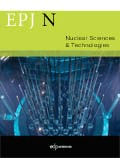
EPJ Nuclear Sciences & Technologies
Scope & Guideline
Transforming Energy Solutions through Nuclear Insights
Introduction
Aims and Scopes
- Nuclear Power and Energy Systems:
Research related to the design, operation, and optimization of nuclear power plants, including simulations and modeling of reactor systems. - Nuclear Safety and Risk Assessment:
Studies that focus on enhancing the safety protocols of nuclear facilities, including probabilistic safety assessments and accident management strategies. - Radioactive Waste Management:
Investigations into the treatment, storage, and disposal of radioactive waste, including innovative conditioning techniques and lifecycle assessments. - Nuclear Data and Structure:
Research aimed at improving the precision of nuclear data and understanding nuclear structure to support reactor studies and safety assessments. - Multi-Physics Modeling:
Development and application of multi-physics models to simulate complex interactions within nuclear reactors for improved safety and efficiency. - Education and Training in Nuclear Sciences:
Exploration of educational initiatives and training programs aimed at developing a skilled workforce in the nuclear sector.
Trending and Emerging
- Sustainable Nuclear Energy Solutions:
Research focused on sustainable practices in nuclear energy, including lifecycle assessments and the integration of renewable energy sources, is gaining traction. - Advanced Reactor Technologies:
There is a growing interest in innovative reactor designs such as small modular reactors (SMRs) and fusion hybrid reactors, reflecting the push for safer and more efficient nuclear systems. - Artificial Intelligence and Machine Learning in Nuclear Science:
The application of AI and machine learning techniques for modeling, safety assessments, and predictive analytics is becoming more prevalent, showcasing a trend towards modernization in nuclear research. - Health Effects of Ionizing Radiation:
Studies exploring the health impacts of ionizing radiation, particularly in medical applications, are increasingly significant, emphasizing the need for improved radiation protection. - Collaboration and Knowledge Management in Nuclear Research:
A notable trend is the emphasis on collaborative research efforts and knowledge management strategies to address complex challenges in nuclear waste management and reactor safety.
Declining or Waning
- Traditional Nuclear Reactor Designs:
There appears to be a decrease in research focused on conventional nuclear reactor designs, as the field shifts towards next-generation systems and innovative reactor technologies. - Basic Radiation Physics:
Research concentrating solely on fundamental aspects of radiation physics has diminished, possibly due to a growing emphasis on applied research and technological advancements. - Conventional Waste Disposal Methods:
Publications on traditional methods of radioactive waste disposal are becoming less frequent as new approaches and technologies are developed and emphasized. - Historical Case Studies of Nuclear Accidents:
Although historical analyses have value, there seems to be a waning interest in detailed case studies of past nuclear accidents, with more focus shifting to prevention and modern safety measures. - Nuclear Fuel Cycle Simulations without Advanced Techniques:
Research that does not incorporate advanced computational techniques for nuclear fuel cycle simulations is less common, indicating a shift towards more sophisticated modeling approaches.
Similar Journals

Nuclear Materials and Energy
Empowering Knowledge in Nuclear Science and MaterialsNuclear Materials and Energy is a premier open-access journal published by Elsevier, dedicated to the dynamic fields of nuclear science and materials engineering. Since its inception in 2015, the journal has made significant strides in disseminating cutting-edge research, establishing itself as a vital resource for researchers and professionals alike. With a commendable impact factor and ranked in the Q2 category for both Materials Science (miscellaneous) and Nuclear and High Energy Physics, and impressively in Q1 for Nuclear Energy and Engineering in 2023, Nuclear Materials and Energy stands out in the academic community. This journal aims to bridge the gap between fundamental research and practical applications, promoting innovative solutions in the efficient utilization of nuclear materials and energy technologies. Open access since 2015, the journal ensures wide dissemination and accessibility of crucial findings, making it an essential platform for advancing knowledge and fostering collaboration in these pivotal fields.

Nuclear Physics and Atomic Energy
Exploring the frontiers of atomic science.Nuclear Physics and Atomic Energy is a reputable open-access journal that focuses on the fields of nuclear physics and high-energy physics, providing a forum for researchers, professionals, and students to share their findings and advancements. Published by the Institute of Nuclear Research, National Academy of Sciences of Ukraine, this journal has been committed to disseminating knowledge since its inception in 2006, ensuring that scientific advancements remain accessible to a global audience. With an ISSN of 1818-331X and an E-ISSN of 2074-0565, the journal features a diverse array of articles that span the continued exploration and application of nuclear phenomena. Although currently categorized in the Q4 quartile for Nuclear and High Energy Physics in 2023, the journal is steadily working towards increasing its impact and engagement within the academic community. With a Scopus rank of #74 out of 87 in its category, it serves as a valuable resource for advancing crucial research in a vital scientific area. Researchers are encouraged to contribute their innovative studies to foster collaboration and knowledge sharing in this dynamic field.
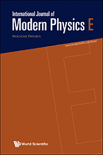
INTERNATIONAL JOURNAL OF MODERN PHYSICS E
Pioneering Discoveries in the Realm of High Energy PhysicsThe INTERNATIONAL JOURNAL OF MODERN PHYSICS E, published by WORLD SCIENTIFIC PUBL CO PTE LTD, serves as a distinctive platform for the dissemination of high-quality research in the fields of Nuclear and High Energy Physics, as well as Physics and Astronomy. With an ISSN of 0218-3013 and covering a timeline from 1996 to 2024, the journal has established itself within the academic community, achieving a respectable Q3 ranking in its respective categories for 2023, underscoring its commitment to advancing knowledge in modern physics. Although it operates without an open access model, the journal's curated content is accessible to a wide audience of researchers, professionals, and students engaged in cutting-edge physics. Set in Singapore, this journal not only contributes to scholarly discussions but also fosters a global collaboration among physicists, making it an invaluable resource for those seeking to deepen their understanding and contribute to ongoing dialogues in the scientific community.
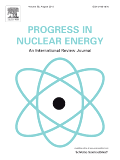
Progress in Nuclear Energy
Advancing sustainable solutions in nuclear energy.Progress in Nuclear Energy is a premier academic journal published by Pergamon-Elsevier Science Ltd, dedicated to advancing the field of nuclear energy and its applications. With an ISSN of 0149-1970 and an E-ISSN of 1878-4224, this journal has made significant contributions to the scholarly community since its inception in 1977. The journal is recognized for its rigorous peer-reviewed research and has achieved impressive standings in multiple categories, including being ranked Q1 in Nuclear Energy and Engineering and Safety, Risk, Reliability and Quality for 2023. Its impact factor highlights the relevance and influence of the published work within the field. Researchers, professionals, and students seeking a comprehensive overview of current developments will find valuable insights in its pages. Covering a broad time span of publishing years, from 1977 through 2024, Progress in Nuclear Energy remains an essential resource for those involved in the energy sector, particularly in designing sustainable and safe nuclear technologies.
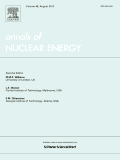
ANNALS OF NUCLEAR ENERGY
Leading the Charge in Nuclear Research and DevelopmentANNALS OF NUCLEAR ENERGY, published by Pergamon-Elsevier Science Ltd, is a premier interdisciplinary journal in the field of nuclear energy and engineering. Holding an impressive Q1 ranking in its category as per the 2023 evaluations, it is recognized for its significant contributions to the advancement of nuclear science and technology. With its extensive publication history since 1975 and a convergence period extending to 2025, the journal aims to disseminate high-quality research, innovative methodologies, and critical reviews that address the challenges and developments in nuclear energy systems. Though the journal does not offer open access options, it remains a vital resource for researchers, professionals, and students seeking to stay abreast of the latest trends and breakthroughs in this essential field. Its commitment to fostering academic discourse ensures that contributors and readers alike are engaged in shaping the future of energy solutions.

ATOMIC ENERGY
Advancing nuclear knowledge for a sustainable future.ATOMIC ENERGY is a distinguished journal published by SPRINGER, focusing on pivotal advancements and research within the field of Nuclear Energy and Engineering. With an ISSN of 1063-4258 and an E-ISSN of 1573-8205, this journal has been a critical resource since its inception in 1956, serving both historic and contemporary scientific inquiries into nuclear technologies. Currently positioned in Q3 of the Nuclear Energy and Engineering category, ATOMIC ENERGY ranks 49 out of 77 in Scopus, representing a percentile of 37%, highlighting its relevance in the research community. While it is not an open access journal, it continues to draw a diverse readership eager to engage with the latest findings and innovations in nuclear science. The journal’s objectives include fostering collaborative research, sharing expertise, and addressing contemporary challenges in nuclear energy. As such, ATOMIC ENERGY remains an essential platform for researchers, professionals, and students alike, contributing significantly to the ongoing dialogue in the field.
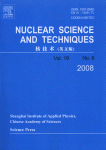
Nuclear Science and Techniques
Fostering Collaboration in the Nuclear CommunityNuclear Science and Techniques is a distinguished peer-reviewed journal published by Springer Singapore Pte Ltd, dedicated to advancing the fields of nuclear science and engineering. With an impressive impact factor reflected in its 2023 quartile rankings—Q2 in Nuclear and High Energy Physics and Q1 in Nuclear Energy and Engineering—the journal serves as a vital resource for researchers, professionals, and students alike. Covering a breadth of topics from nuclear physics to energy applications, it offers a platform for innovative research and developments in the nuclear domain. The journal, indexed under ISSN 1001-8042 and E-ISSN 2210-3147, aims to foster scientific exchange and collaboration within the community by publishing high-quality articles that contribute significantly to the field. Committed to maintaining an open-access ethos, it enhances visibility and accessibility of critical knowledge, making it an essential source for current insights and trends in nuclear science.
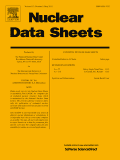
NUCLEAR DATA SHEETS
Advancing Nuclear Knowledge, One Sheet at a Time.NUCLEAR DATA SHEETS is a premier journal published by Academic Press Inc. Elsevier Science, dedicated to advancing the field of nuclear and high-energy physics. With an impressive impact factor and a distinguished Q2 ranking in the pertinent category as of 2023, this journal is recognized for its significant contributions to the synthesis and dissemination of nuclear data, serving as an essential resource for researchers, professionals, and students alike. The journal has been in continuous publication since 1971, making it a cornerstone of knowledge in the discipline as it converges into 2024. Researchers can explore a plethora of meticulously curated articles that cover the latest findings, theoretical advancements, and experimental results in nuclear data, with the objective of fostering collaboration and innovation within the scientific community. While currently not open access, its publications are accessible through institutional subscriptions, ensuring a wide reach amongst academic and research institutions worldwide. With a high Scopus rank of #10 out of 87 in its field, NUCLEAR DATA SHEETS remains an authoritative source that is instrumental in shaping the future of nuclear physics research.
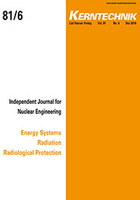
KERNTECHNIK
Bridging research and industry for nuclear advancements.KERNTECHNIK is a distinguished journal specializing in the fields of Materials Science, Nuclear and High Energy Physics, and Nuclear Energy and Engineering. Published by WALTER DE GRUYTER GMBH, this journal has continuously contributed to advancing knowledge and research in nuclear technologies and related safety measures since its inception in 1969. With an ISSN of 0932-3902 and an E-ISSN of 2195-8580, KERNTECHNIK serves as a vital platform for academics and professionals seeking to delve into both theoretical and practical aspects of nuclear science and technology. Though listed in the Q4 quartile across multiple categories in 2023, the journal's commitment to publishing rigorously peer-reviewed articles ensures that it remains a respected resource, facilitating academic discourse and innovation. It is particularly aligned for those conducting research or working in safety, risk, reliability, and quality within the nuclear sector, and its extensive historical archive allows for in-depth exploration of evolving technologies. Aimed at foster cooperation between researchers, policymakers, and industry experts globally, KERNTECHNIK continues to play an important role in shaping the future of nuclear science.
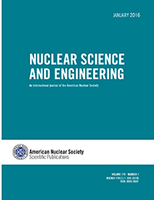
NUCLEAR SCIENCE AND ENGINEERING
Your Gateway to Cutting-Edge Nuclear ResearchNUCLEAR SCIENCE AND ENGINEERING, published by Taylor & Francis Inc, is a leading journal in the field of nuclear energy and engineering, providing a vital platform for disseminating cutting-edge research and advancements from both academia and industry. With an ISSN of 0029-5639 and an E-ISSN of 1943-748X, the journal boasts a notable impact factor and is categorized in the Q2 quartile for 2023, reflecting its influence and quality in the field. Covering a comprehensive scope from the inception of nuclear technology in 1969 to contemporary advancements forecasted for 2024, it ranks #38 out of 77 in the Scopus Energy – Nuclear Energy and Engineering category, placing it in the 51st percentile. Although the journal is not open access, it remains essential for researchers, professionals, and students seeking to stay abreast of the latest developments and innovations in nuclear science. Located in the heart of Philadelphia, NUCLEAR SCIENCE AND ENGINEERING contributes significantly to the advancement of nuclear engineering knowledge and practice, making it a crucial resource for anyone involved in this dynamic field.